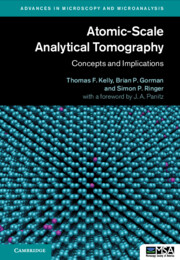Book contents
- Atomic-Scale Analytical Tomography
- Advances in Microscopy and Microanalysis
- Atomic-Scale Analytical Tomography
- Copyright page
- Dedication
- Contents
- Foreword
- Atomic-Scale Analytical Tomography (ASAT)
- Preface
- Acknowledgments
- Introductory Section
- Core Section
- 4 Has ASAT Been Achieved?
- 5 How ASAT Might Be Achieved
- 6 Instrumentation for ASAT
- 7 Practical ASAT
- 8 Toward Real-Space Crystallography
- 9 Experimental Metrics for ASAT
- Implications Section
- Index
- References
7 - Practical ASAT
from Core Section
Published online by Cambridge University Press: 03 March 2022
- Atomic-Scale Analytical Tomography
- Advances in Microscopy and Microanalysis
- Atomic-Scale Analytical Tomography
- Copyright page
- Dedication
- Contents
- Foreword
- Atomic-Scale Analytical Tomography (ASAT)
- Preface
- Acknowledgments
- Introductory Section
- Core Section
- 4 Has ASAT Been Achieved?
- 5 How ASAT Might Be Achieved
- 6 Instrumentation for ASAT
- 7 Practical ASAT
- 8 Toward Real-Space Crystallography
- 9 Experimental Metrics for ASAT
- Implications Section
- Index
- References
Summary
This chapter looks, not at the big picture, but at the details of an operational ASAT instrument. Can specimens withstand repeated STEM/APT cycling? Is an integrated STEM/APT instrument needed or can they be coupled by a vacuum transport? Will specimen evolution models suffice to deliver a realistic model of the specimen shape throughout an ASAT experiment? In an integrated instrument, can APT and STEM be operated simultaneously? Concerns about radiation damage in ASAT experiments and means for mitigating these effects are explored. The role of electron diffraction in ASAT is considered, and it is seen as an important adjunct to atom probe crystallography. The importance of complementary analytical information such as EDS and especially EELS is illustrated. Since atom probe tomography is a compositional mapping tool, EELS as a chemical mapping tool takes on added import. The interplay among the many elements of ASAT and its intrinsic correlative microscopy opportunities serve as an internal check on results. A synergistic ecosystem of AST information with chemical information correlated with physical properties and image simulations defines the opportunity inherent in Atomic-Scale Analytical Tomography.
Keywords
- Type
- Chapter
- Information
- Atomic-Scale Analytical TomographyConcepts and Implications, pp. 125 - 144Publisher: Cambridge University PressPrint publication year: 2022



